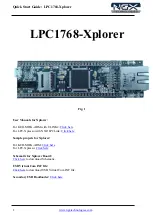
Circuit Details and Configuration
Table 7. J3, V3P3 Pin Circuit Configuration
Header Name
Position
Purpose
1 - 2
External V3P3 source in circuit (default).
J3
OFF
External V3P3 source in circuit
Table 8. J4, V3P3 Pin Capacitor Circuit Configuration
Header Name
Position
Purpose
1 - 2
External V3P3 source in circuit 1-
µ
F + 4.7-
µ
F
capacitance used (default).
J4
OFF
Internal V3P3 source in circuit and 1-
µ
F capacitance
used
Table 9. J5, SENSEP Pin Circuit Configuration
Header Name
Position
Purpose
1 - 2
SENSEP connected to sense resistor for normal operation
(default).
J5
OFF
SENSEP disconnected from sense resistor. This is a test mode
operation where a mV source is applied to J5:pin 1 for simulation
of current.
Table 10. J6, DVCC Pin Circuit Configuration
Header Name
Position
Purpose
1 - 2
Power to MSP430 during programming is from VCC-Tool. (default)
J6
2 - 3
Power to MSP430 during programming is from VCC-Target.
2.2.1
Cell Simulator DIP Switch (S4)
The eight-position DIP switch (S4) allows the user to simulate cell-voltage inputs to the bq76925 rather
than supply actual cell voltages. See
for details of the operation of the DIP switch.
CAUTION
Use silkscreen labeling and square pin 1 pad to determine orientation and
operation of the eight-position DIP switch. Ignore numbers actually printed on
the switch.
All S4 dip switches must be opened when using a battery with the EVM.
Table 11. DIP Switch, S4
Switch
Terminal
Label
Purpose
Name
S4
1
Battery
Switch to connect power supply to resistor network. Closure
activates LED D13.
2
Cell 6
Applies simulated cell voltage to VC6.
3
Cell 5
Applies simulated cell voltage to VC5.
4
Cell 4
Applies simulated cell voltage to VC4.
5
Cell 3
Applies simulated cell voltage to VC3.
6
Cell 2
Applies simulated cell voltage to VC2.
7
Cell 1
Applies simulated cell voltage to VC1.
8
Cell 0
Applies simulated cell voltage to VC0.
9
SLUU514
–
July 2011
bq76925EVM Evaluation Module
Copyright
©
2011, Texas Instruments Incorporated









































